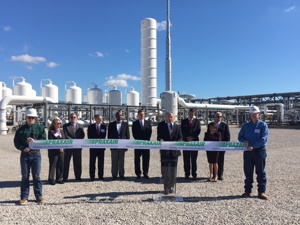Praxair launches hydrogen recovery unit to support Dow's Freeport operations
FREEPORT, Texas -- Praxair completed a new hydrogen recovery and processing plant at the company’s Freeport, Texas production complex. The company held a ribbon cutting ceremony at the facility on Jan. 31 (FIG. 1). The new hydrogen facility will recover by-product hydrogen from Dow Chemical’s ethylene production facilities, and upgrade it into high-purity hydrogen by using a pressure swing adsorption process.

The plant began operations in December 2016, and now supplies high-purity hydrogen back to Dow in order to meet Dow’s needs across Southeast Texas. Dow is investing more than $6 B in Texas and Louisiana. These investments are strengthening the competitiveness of the company’s high-value Performance Plastics franchise and Performance Products businesses. Dow also will receive nitrogen from Praxair’s new air separation unit, which is presently under construction. Dow will utilize the hydrogen and nitrogen to support the production of specialty chemicals used in several diverse end-markets, including automobile manufacturing, coating applications and chemical intermediates.
Praxair also will supply its customers on the US Gulf Coast via the new hydrogen pipeline recently completed between Freeport and the pipeline terminus in Texas City, Texas. Additionally, Praxair is building two other manufacturing facilities at its Freeport complex, which will be completed by 2019. These units will supply manufacturers in the region with oxygen, nitrogen, argon and CO2. These investments, along with a nitrogen pipeline between Freeport and Texas City, represent over $400 MM in total costs.
The process. It all begins with adsorption, which removes impurities from the feed gas, in this case, by-product hydrogen streams from Dow’s ethylene production. The adsorption takes place in a vessel packed with selected layers of adsorption materials. Once the major impurities are removed, the high-purity hydrogen is compressed for distribution. When the adsorption bed is fully loaded with impurities, it is taken offline for regeneration, and the feed gas is fed to another, already regenerated, vessel; and the cycle starts again. Altogether, Praxair’s system has 14 adsorption vessels operating in a complex cyclic pattern. The process produces on-specification hydrogen with higher recovery rates, less waste and lower CO2. By recovering the by-product hydrogen, rather than producing hydrogen through the reforming of natural gas, the process prevents 300 Mtpy of direct CO2 emissions versus other conventional means.






Comments